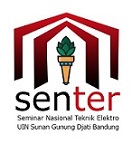Analisis Kinerja Jaringan Sensor Kelembaban Tanah Pada Prototipe Pendeteksi Kebocoran Pipa Air Berbasis IoT
Keywords:
Sensor kelembaban tanah YL-69, NodeMCU, Firebase, MIT App InventorAbstract
Internet of Things merupakan suatu konsep yang bertujuan untuk memperluas manfaat dari konektivitas internet. Kebocoran saluran pipa air bersih merupakan masalah utama yang sering terjadi pada perusahaan air, oleh karena itu dibutuhkan solusi yang tepat untuk mengetahui titik letak kebocoran pada saluran pipa air bersih. Kebocoran pipa akan lebih mudah dideteksi dan ditangani jika pipa tersebut berada di permukaan tanah. Saluran pipa air yang terletak di bawah tanah akan lebih sulit untuk dideteksi letak titik kebocorannya. Salah satu contoh solusi untuk mengetahui titik letak kebocoran pipa yang berada di bawah tanah adalah dengan melakukan monitoring pada kelembaban tanah. Perancangan dan penelitian ini difokuskan untuk menganalisis kinerja jaringan sensor kelembaban tanah pada prototipe pendeteksi kebocoran pipa. Pembuatan sistem pendeteksi kebocoran pipa di bawah tanah dengan sensor kelembaban tanah supaya dapat mengetahui letak area yang terjadi kebocoran pipa menggunakan platform MIT App Inventor dan firebase sebagai database. Dalam membangun sistem pendeteksi kebocoran pipa di bawah tanah dengan sensor kelembaban tanah YL-69 berbasis IoT, maka dibutuhkan pengujian delay dan data error rate untuk mengetahui kulaitas jaringan sensor tersebut. Berdasarkan hasil penelitian disimpulkan bahwa sistem pendeteksi kebocoran pipa di bawah tanah dengan sensor kelembaban tanah YL-69 berbasis IoT dapat mengirim data hasil pembacaan sensor menuju firebase sebagai database dan platform MIT App Inventor. Dari hasil perbandingan waktu pengiriman data bahwa penerimaan data ke database maupun App Inventor tergantung oleh jaringan wifi yang terhubung oleh nodeMCU.
The Internet of Things is a concept that aims to expand the benefits of internet connectivity. Leakage of clean water pipelines is the main problem that often occurs in water companies, therefore the right solution is needed to find out the location of leaks in clean water pipelines. Pipe leaks will be easier to detect and handle if the pipes are at ground level. Water pipelines located underground will be more difficult to detect the location of the leakage point. One example of a solution to find out the location point of pipe leaks underground is to monitor soil moisture. This design and research is focused on analyzing the performance of the soil moisture sensor network on the pipe leak detection prototype. Creation of an underground pipe leak detection system with soil moisture sensors to find out the location of the area where the pipe leak occurred using the MIT App Inventor platform and firebase as a database. In building an underground pipe leak detection system with IoT-based YL-69 soil moisture sensors, delay testing and error rate data are needed to determine the quality of the sensor network. Based on the results of the study, it was concluded that an underground pipe leak detection system with an IoT-based YL-69 soil moisture sensor can send sensor reading data to firebase as a database and MIT App Inventor platform. From the results of the comparison of data transmission time that the receipt of data to the database or App Inventor depends on the wifi network connected by the nodeMCU.
Downloads
References
D. Taryana, “Perancangan Jaringan Pendeteksi Kebocoran Pipa Air Bawah Tanah Menggunakan Teknologi WSN (Wireless Sensor Network),” Universitas Telkom , Bandung, 2018.
M. Elleuchi, R. Khelif, M. Kharrat, M. Aseeri, A. Obeid dan M. Abid, “Water Pipeline Monitoring and Leak Detection using soil moisture sensors: IoT based solution,” International Multi - Conference on Systems, Signals and Devices, Vol. %1 dari %2-, no. -, pp.772-775, 2019.
S. A. Nugroho, “Analisis Kelembaban Tanah Permukaan melalui Citra Landsat 7 ETM+ di Wilayah Dataran Kabupaten Purworejo,” Universitas Muhammadiyah Surakarta, Surakarta, 2011.
R. F. Swarna, “Sistem Monitor Dan Kontrol Kelembaban Tanah Menggunakan Arduino Berbasis Internet of Things,” Universitas Islam Indonesia , Yogyakarta, 2016.
F. Susanto, N. K. Prasiani dan P. Darmawan, “IMPLEMENTASI INTERNET OF THINGS DALAM KEHIDUPAN SEHARI-HARI,” JURNAL IMAGINE, vol. 2 No1 , pp. 35-40, 2022.
G. Wang, C. Gu, J. Rice, T. Inoue, and C. Li, “Highly accurate noncontact water level nitoring using continuous-wave Doppler radar,” WiSNet 2013 - Proc. 2013 IEEE Top. Conf. el. Sensors Sens. Networks - 2013 IEEE Radio Wirel. Week, RWW 2013, no. January, pp. 19– 2013, doi: 10.1109/WiSNet.2013.6488620.
M. Khan, B. N. Silva, and K. Han, “Internet of Things Based Energy Aware Smart Home Control System,” IEEE Access, vol. 4, pp. 7556–7566, 2016, doi: 10.1109/ACCESS.2016.2621752.
A.B. Primawan, Performance Analysis of Data Transmission Device in Wireless Sensor Network, International Journal of Engineering Trends and Technology 68.3(2020):1-5.
P. Sindu Prawito and H. P. Perdana, “Aplikasi Sistem Manajemen Belajar Berbasis Web Dengan Framework Laravel di Growth2tech,” Syntax Lit. ; J. Ilm. Indones., vol. 5, no. 3, p. 100, 2020, doi: 10.36418/syntax-literate.v5i3.981



